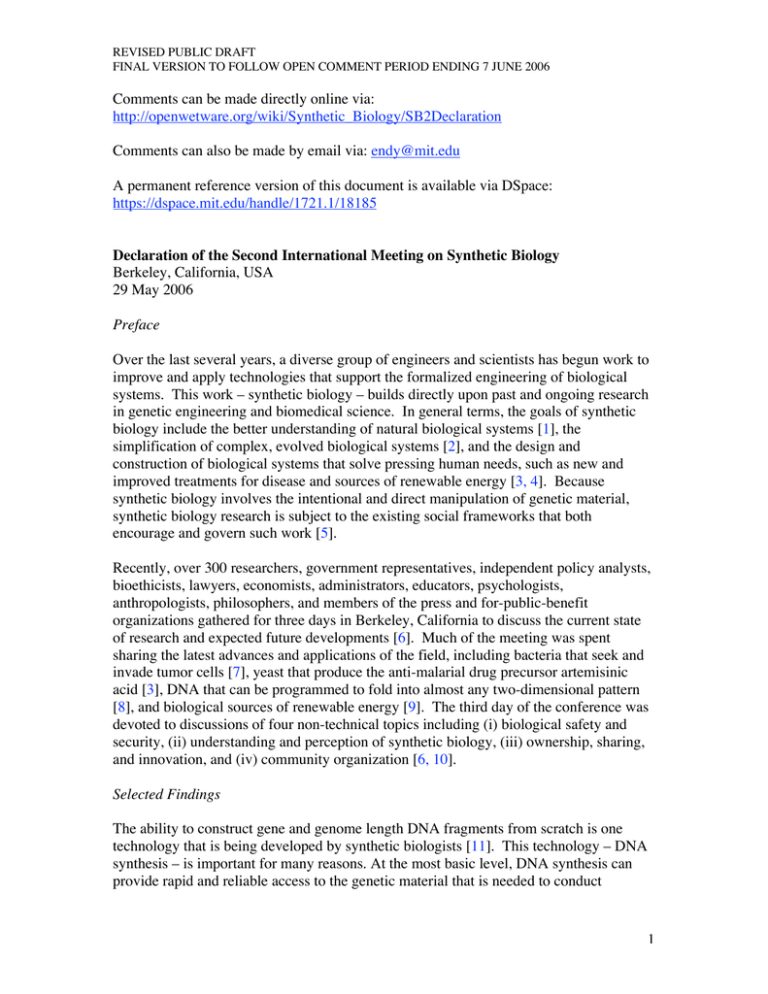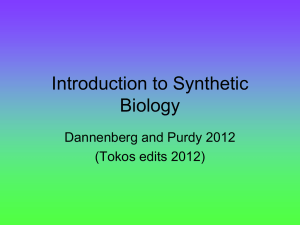Comments can be made directly online via:
advertisement

REVISED PUBLIC DRAFT FINAL VERSION TO FOLLOW OPEN COMMENT PERIOD ENDING 7 JUNE 2006 Comments can be made directly online via: http://openwetware.org/wiki/Synthetic_Biology/SB2Declaration Comments can also be made by email via: endy@mit.edu A permanent reference version of this document is available via DSpace: https://dspace.mit.edu/handle/1721.1/18185 Declaration of the Second International Meeting on Synthetic Biology Berkeley, California, USA 29 May 2006 Preface Over the last several years, a diverse group of engineers and scientists has begun work to improve and apply technologies that support the formalized engineering of biological systems. This work – synthetic biology – builds directly upon past and ongoing research in genetic engineering and biomedical science. In general terms, the goals of synthetic biology include the better understanding of natural biological systems [1], the simplification of complex, evolved biological systems [2], and the design and construction of biological systems that solve pressing human needs, such as new and improved treatments for disease and sources of renewable energy [3, 4]. Because synthetic biology involves the intentional and direct manipulation of genetic material, synthetic biology research is subject to the existing social frameworks that both encourage and govern such work [5]. Recently, over 300 researchers, government representatives, independent policy analysts, bioethicists, lawyers, economists, administrators, educators, psychologists, anthropologists, philosophers, and members of the press and for-public-benefit organizations gathered for three days in Berkeley, California to discuss the current state of research and expected future developments [6]. Much of the meeting was spent sharing the latest advances and applications of the field, including bacteria that seek and invade tumor cells [7], yeast that produce the anti-malarial drug precursor artemisinic acid [3], DNA that can be programmed to fold into almost any two-dimensional pattern [8], and biological sources of renewable energy [9]. The third day of the conference was devoted to discussions of four non-technical topics including (i) biological safety and security, (ii) understanding and perception of synthetic biology, (iii) ownership, sharing, and innovation, and (iv) community organization [6, 10]. Selected Findings The ability to construct gene and genome length DNA fragments from scratch is one technology that is being developed by synthetic biologists [11]. This technology – DNA synthesis – is important for many reasons. At the most basic level, DNA synthesis can provide rapid and reliable access to the genetic material that is needed to conduct 1 REVISED PUBLIC DRAFT FINAL VERSION TO FOLLOW OPEN COMMENT PERIOD ENDING 7 JUNE 2006 experiments and synthesize useful products. Advances in DNA synthesis, such as reduced costs and improved speed and accuracy, are expected to result in direct and widespread improvements to the process of basic and applied biological research and, in turn, result in widespread public benefits. DNA synthesis is already a relatively cheap technology that is widely distributed [12]; the technology is often provided as a service by commercial firms that accept orders via the internet. Unfortunately, despite several years of ad hoc encouragement and inquiries to different government agencies, not all DNA synthesis companies examine their orders for DNA sequences encoding hazardous biological systems. For example, a recent investigative survey found that only five of twelve DNA synthesis companies systematically check their orders to ensure that they are not unknowingly constructing and delivering the genetic material encoding hazardous biological systems, such as human pathogens [13]. Thus, DNA synthesis currently provides a plausible path for circumventing current best practice in biological safety, including institutional, peer, or government review of genetic research. Furthermore, because a small number of individuals, groups, or nations may continue to choose to intentionally misapply biological technologies, DNA synthesis, as currently practiced and given current biological security strategy, is likely to eventually facilitate the production of threats to human and environmental health [14]. The companies that already systematically check DNA synthesis orders rely on software tools for identifying the genetic sequences that encode hazardous biological systems. At least one tool, BlackWatch, is known to be in use at more than one company [15]. Importantly, the existing software tools have flaws that include an inability to identify novel hazardous systems and a high false alarm rate; the second flaw makes such tools impractical for use at high-volume DNA synthesis providers. Resolutions To begin to address the issues introduced above, we endorse the following [16]: First, we support the organization of an open working group that will undertake the coordinated development of improved software tools that can be used to check DNA synthesis orders for DNA sequences encoding hazardous biological systems; we expect that such software tools will be made freely available. Second, we support the adoption of best-practice sequence checking technology, including customer and order validation, by all commercial DNA synthesis companies; we encourage individuals and organizations to avoid patronizing companies that do not systematically check their DNA synthesis orders [17]. Third, we support ongoing and future discussions within international science and engineering research communities for the purpose of developing creative solutions and frameworks that directly address challenges arising from the ongoing advances in biological technology, in particular, challenges to biological security and biological justice [18]. 2 REVISED PUBLIC DRAFT FINAL VERSION TO FOLLOW OPEN COMMENT PERIOD ENDING 7 JUNE 2006 Fourth, we support ongoing and future discussions with all stakeholders for the purpose of developing and analyzing inclusive governance options, including self-governance, that can be considered by policymakers and others such that the development and application of biological technology remains overwhelmingly constructive. Immediate Next Steps In support of the first and second resolutions, the open working group that will undertake the coordinated improvement of software tools for checking DNA sequences is being formed and should begin work no later than August of 2006. An announcement will be made when the initial organizational work is complete [19]. A publicly available technical progress report from this group will be expected at or before the Third International Meeting on Synthetic Biology [20]. In support of the third and fourth resolutions, an ongoing multi-stakeholder study sponsored by the Alfred P. Sloan Foundation to develop policy options that might be used to govern DNA synthesis technology will be completed [21]. All materials from this study will be presented to government representatives and made available to the public by November of 2006. Finally, all interested parties are invited to work together to continue to identify and directly address societal issues associated with the development of synthetic biology [10]. References 1. Reconstruction of genetic circuits. D. Sprinzak & M.B. Elowitz, Nature. 24 November 2005. v438 p443. 2. Refactoring bacteriophage T7. L.Y. Chan et al., Molecular Systems Biology. 13 September 2005. doi:10.1038/msb4100025 3. Production of the antimalarial drug precursor artemisinic acid in engineered yeast. D.K. Ro et al., Nature. 13 April 2006. v440 p940. 4. Foundations for engineering biology. D. Endy., Nature. 24 November 2005. v438 p439. 5. For example, in the United States, publicly funded research is subject to oversight via the National Institutes of Health Office of Biotechnology Activities. http://www4.od.nih.gov/oba/ 6. SB2.0, The Second International Meeting on Synthetic Biology. 20-22 May 2006. Berkeley, CA, USA. http://pbd.lbl.gov/sbconf/ 7. Environmentally controlled invasion of cancer cells by engineered bacteria. J.C. Anderson et al., Journal of Molecular Biology. 27 January 2006. v355 p619. 8. Folding DNA to create nanoscale shapes and patterns. P.W. Rothemund, Nature. 16 March 2006. v440 p297. 9. For example, Green Fuel Technologies Corporation, http://www.greenfuelonline.com/ 10. Synthetic Society Working Group, http://openwetware.org/wiki/Synthetic_Society 3 REVISED PUBLIC DRAFT FINAL VERSION TO FOLLOW OPEN COMMENT PERIOD ENDING 7 JUNE 2006 11. Building a fab for biology. D. Baker et al., Scientific American. June 2006. p44. 12. A genome shop near you. R. Carlson et al., WIRED. December 2005. v13.12. 13. The bioweapon is in the post. P. Aldhous. New Scientist. 9 November 2005. 14. In search of biosecurity. D.A. Relman et al. Science. 31 March 2006. v311 p1835. 15. BlackWatch, Hazardous Biological Agent Sequence Detection, http://biotech.craic.com/blackwatch/ 16. Here, “we” refers to the conferees of the Second International Conference on Synthetic Biology except for the following individuals who have either objected to this document or have asked to abstain: n/a. 17. Consistent with the first and second options from S.M. Maurer et al., From understanding to action: community-based options for improving safety and security in synthetic biology. Goldman School of Public Policy, UC Berkeley. April 2006. 18. For example, Biotechnology research in an age of terrorism. G. Fink et al. The National Academies Press (2004). As a second example, Redesigning life: the worldwide challenge to genetic engineering. B. Tokar et al. Zed Books (2001). 19. An announcement regarding the DNA sequence checking working group will be posted via http://www.syntheticbiology.org/ 20. SB3.0, The Third International Meeting on Synthetic Biology. June 2007. Zurich, Switzerland. http://www.syntheticbiology.ethz.ch/conf_2007/ 21. The Alfred P. Sloan Foundation is a philanthropic nonprofit institution. http://www.sloan.org/ 4





